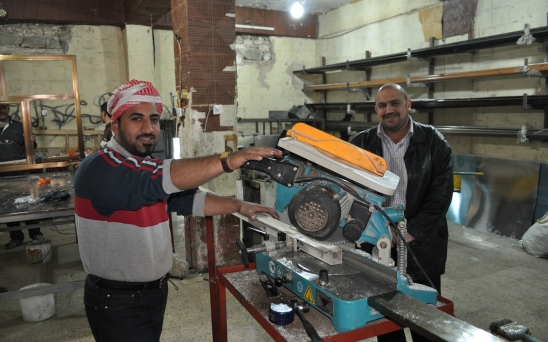General introduction:
A 2011 World Bank study on Iraq’s financial sector indicates that bank credit in Iraq amounts to only 10% of GDP and would need to rise by an additional $38 billion to catch up to the MENA average of 55%.
In a Market Assessment in 2010, over 700 Iraqi MSMEs were interviewed on their major business constraints and opportunities. Results revealed that access tofinance continue to be an extremely critical aspect for the growth and development of SMEs in the country. Surveyed companies ranked access tofinance
at the top of most debilitating constraints, even more important than security issues. This constraint didn’t show to be a concern of a specific sector. The results were supported by the fact of finding a great majority of enterprises whose books showed only small amounts of payables and debt to others, or did not show them at all.
Demand side:
In another report titled “Access to Finance by Micro, Small and Medium Enterprises in Iraq” (2010), it was calculated the demand for loans among MSMEs by asking 8.737 business owners (and principals) about the amount of money they would need, after declaring that they were planning to invest additional capital in the business in the next 24 months. The demand was calculated in 422 billion dinars, which represent an average of 37,8 million dinars per enterprise. The current (2010) average indebtedness of enterprises is of 3.5 million dinars.32
Iraq remains the most underserviced nation in the MENA region, measured in terms of private bank branches per capita. In addition, the location of branches are disproportionately to the population in the different provinces, leading to the result that 63% of SME lending volume goes to only 33% of the provinces.33
Studies estimate that the financing demand for credit of the top 15% of small businesses in Iraq alone exceeds the currently provided $200-$300 million by $1,6 billion. A small-scale study from 2012 by the local University of Kurdistan Hawler (UKH) on 30 SMEs in the Kurdistan region reveals that the vast majority of workers are unskilled (more than 75%), the majority of 2/3 rely solely on self-financing
. Only about 1/3 keep any kind of consistent financial records. 80 percent have applied for a loan in the past but less than half of them qualified to receive it. 1/3 of the responding SME participated in BDS programs.
The demand in Iraq for Islamic Finance is high, with a high percentage of SMEs that prefer a Shari´a compliant financing.
Supply side:
It is estimated that in 2010, public banks (controlling 85 – 90 percent of bank resources) lent only 10% of their balance sheet as cash credit to the private sector, compared to 30% for private banks. According to CBI data, Iraqi private commercial banks lent $ 2.5 billion in 2010, including an estimated $250 million to SMEs, which represents a high contribution to the SME sector than public banks, lending only $200 million of the total of $5,6 billion private sector exposure.
However, it becomes evident when analysing Iraqi banks’ annual financial statement that private commercial banks do not put an emphasis on lending in general, and on lending to SMEs in particular. In 2010, 32 percent of private bank resources was kept as deposits with the Central Bank and over half of all assets was invested outside the private sector loan market. Most banks are profitable and highly liquid, achieving their revenues not from net interest business (est. SME lending 5%, consumer and corporate loans 15%, deposits 14%) but from non-interest activities such as money transfers, foreign exchange, Letters of Guarantee (LGs), Letters of Credit (LCs), etc.
USAID involvement in SME Finance:
When analysing the finance environment for SMEs in Iraq, one cannot ignore the evident presence of USAID in the sector. Since 2003 alone, USAID has invested
over $8 billion through different programmes. Under the “Economic Growth and Agriculture” Initiative, the programmes “Provincial Economic Growth Programme USAID Tijara” and the “Financial Development Project” are of particular relevance for the finance environment of SMEs in Iraq.
The $53 million budget Financial Sector Development Project works primarily with the Central Bank of Iraq. This five-year program is designed to improve the soundness of the Iraqi private financial sector through institution strengthening, targeted economic reforms, and improving the quality and availability of finance and business education.
The Tijara programme (Tijara means “trade” in Arabic) is the successor of the Izdihar programme (Izdihar means “prosperity” in Arabic) which was implemented by USAID in the years 2004 – 2008 with the aim to expand the Iraqi private sector and create jobs by developing a more market-friendly environment for economic growth.
Tijara has a $174 million budget and ends by 2013.36 The programme has conducted the most recent and comprehensive studies available on private sector development, MSMEs and their access to financial services. It has supported in particular the private banking and finance sector since 2008. It includes strong support to the emerging microfinance sector, establishment and support of small business development centres (SBDSc) and the support of their training services to SMEs as well as the establishment of support apex institutions such as the Iraqi Company for Bank Guarantees (ICBG) and Iraqi Compan
y for Financing SMEs (ICFSME). Tijara has also promoted the establishment of SME lending units at 13 private banks with 151 branches, including training to the staff. Tijara furthermore advices the Government in new introduction of new policies to promote trade, investment and an improved business enabling environment.
By Hawrre Hassari
Source: https://www.linkedin.com/pulse/access-financial-services-smes-iraq-hawrre-hassari




![The Japan provides support to revitalize community services for returnee communities in Diyala governorate [EN/AR]](https://iraqieconomists.net/en/wp-content/uploads/sites/3/2020/06/Homes-and-public-buildings-are-badly-damaged_Al-Udheim_Diyala_KatePond-510x369.jpg)



Comment here